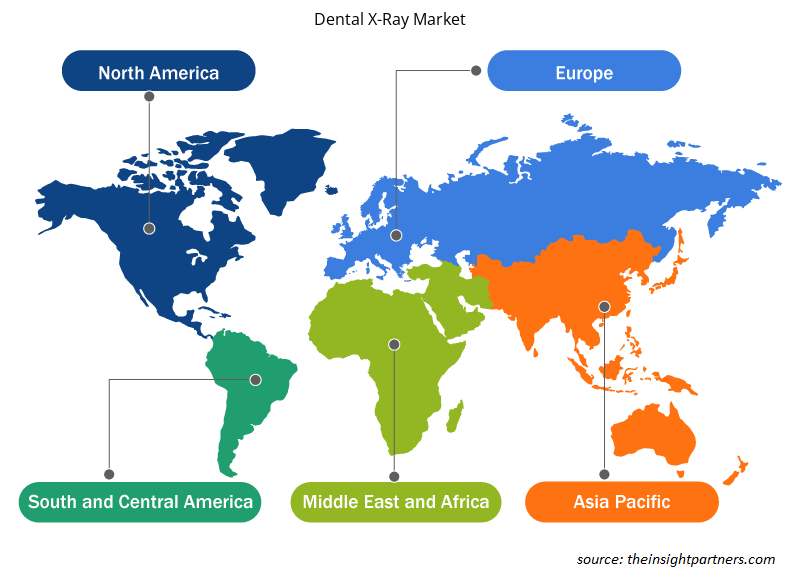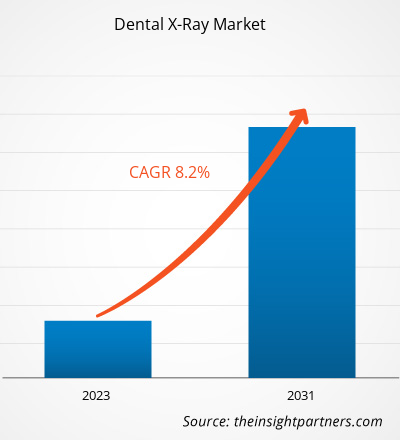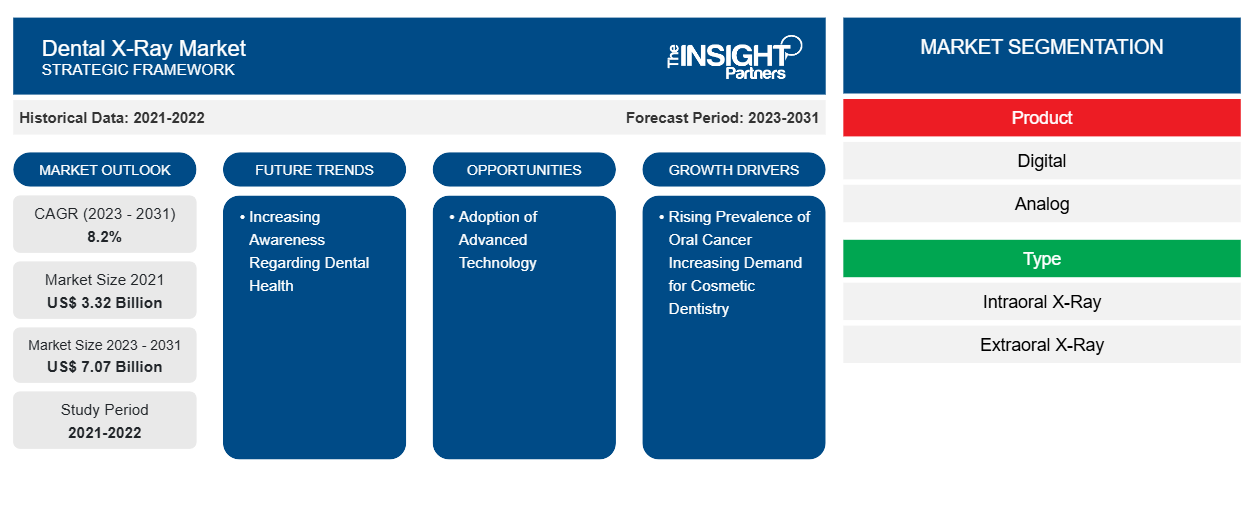La taille du marché des rayons X dentaires en 2021 s'élevait à 3,32 milliards USD et devrait atteindre 7,07 milliards USD d'ici 2031, contre XX milliards USD en 2023. Le marché devrait enregistrer un TCAC de 8,2 % en 2023-2031. L'adoption de technologies de pointe telles que l'utilisation du système de tomodensitométrie à faisceau conique (CBCT) devrait rester l'une des principales tendances du marché des rayons X dentaires.
Analyse du marché des radiographies dentaires
Des contrôles dentaires réguliers, associés à une utilisation appropriée des rayons X, contribuent à maintenir une excellente santé bucco-dentaire et à prévenir l'évolution des maladies dentaires. L'acceptation croissante de la dentisterie esthétique, l'augmentation des problèmes dentaires et le vieillissement de la population sont les principaux facteurs qui stimulent le marché des rayons X dentaires.
Aperçu du marché des radiographies dentaires
Les appareils de diagnostic sont désormais indispensables dans la dentisterie moderne pour fournir des soins précis et complets aux patients. Parmi ces outils, les radiographies dentaires se distinguent comme un élément essentiel du diagnostic. Les radiographies dentaires sont devenues un outil de diagnostic essentiel dans la dentisterie moderne, améliorant considérablement la qualité globale des soins aux patients. De la détection précoce des troubles dentaires à la planification précise du traitement, les avantages des rayons X sont indéniables.
Personnalisez ce rapport en fonction de vos besoins
Vous bénéficierez d'une personnalisation gratuite de n'importe quel rapport, y compris de certaines parties de ce rapport, d'une analyse au niveau des pays, d'un pack de données Excel, ainsi que de superbes offres et réductions pour les start-ups et les universités.
-
Obtenez les principales tendances clés du marché de ce rapport.Cet échantillon GRATUIT comprendra une analyse de données, allant des tendances du marché aux estimations et prévisions.
Facteurs moteurs et opportunités du marché des rayons X dentaires
La prévalence croissante du cancer de la bouche devrait favoriser la croissance du marché
L'incidence des problèmes bucco-dentaires est en hausse partout dans le monde, comme les traitements de canal, la perte de dents, la bouche sèche, les caries, le cancer de la bouche et d'autres. La perte de dents, les caries et les traitements de canal sont les principaux problèmes dentaires auxquels sont confrontées les personnes du monde entier. Le cancer de la bouche est classé au sixième rang des cancers les plus courants au Royaume-Uni, chaque année, environ 4 900 nouveaux cas sont signalés dans le pays. Les rayons X sont utilisés pour évaluer si le cancer a progressé vers d'autres organes que la bouche et l'oropharynx.
Sensibilisation accrue à la santé dentaire
La Journée mondiale de la santé bucco-dentaire a été instaurée par la Fédération dentaire internationale (FDI) et constitue la plus grande campagne mondiale de sensibilisation à la santé bucco-dentaire. Cette campagne annuelle sensibilise les enfants et les adultes aux pratiques d'hygiène bucco-dentaire et explique l'importance de la santé bucco-dentaire dans le maintien de la santé et du bien-être en général. Par exemple, la FDI lancera en 2024 la campagne « UNE BOUCHE HEUREUSE, C'EST UN CORPS HEUREUX », encourageant le public à comprendre les avantages d'une bouche saine et heureuse en mettant en lumière le lien complexe entre la santé générale et la santé bucco-dentaire. L'objectif de la campagne est de motiver les gens à prendre soin de leur bouche et de comprendre qu'en agissant ainsi, ils peuvent également contribuer à protéger leur bien-être général. La campagne vise à sensibiliser à la santé dentaire, car elle offre la possibilité de réaliser une radiographie dentaire.FDI) and is the largest global awareness campaign on oral health. The annual campaign spreads awareness about oral hygiene practices for children and adults and explains the significance of oral health in maintaining general health and well-being. For instance, FDI will be leading with ‘’A HAPPY MOUTH, IS A HAPPY BODY’’ in 2024, encouraging the public to understand the benefits of a healthy and happy mouth by shedding light on the complicated link between general health and oral health. The aim of the campaign is to motivate people to take care of their mouths and understand that by doing so, they can also help protect their overall well-being. The campaign is for spreading awareness regarding dental health, as it has an opportunity for dental X-ray.
Analyse de segmentation du rapport sur le marché des rayons X dentaires
Les segments clés qui ont contribué à l’élaboration de l’analyse du marché des rayons X dentaires sont le produit, le type et l’application.
- En fonction du produit, le marché de la radiographie dentaire est divisé en numérique et analogique. Le segment numérique détenait une part de marché plus importante en 2023.
- En termes de type, le marché est divisé en radiographie intraorale et radiographie extraorale. Les radiographies interproximales, périapicales et occlusales sont des sous-segments importants du segment des radiographies intraorales. De plus, la CBCT, la radiographie panoramique et d'autres sont des sous-segments élaborés dans le cadre du segment des radiographies extraorales. Le segment des radiographies intraorales a dominé le marché en 2023.
- En termes d'application, le marché est segmenté en médecine, cosmétiques et médecine légale. Le segment médical détenait la plus grande part du marché en 2023.
Analyse des parts de marché des radiographies dentaires par géographie
La portée géographique du rapport sur le marché des rayons X dentaires est principalement divisée en cinq régions : Amérique du Nord, Asie-Pacifique, Europe, Moyen-Orient et Afrique, et Amérique du Sud et centrale.
L'Amérique du Nord domine le marché de la radiographie dentaire. La croissance du marché en Amérique du Nord est due à divers facteurs tels que la sensibilisation croissante à l'imagerie dentaire, les investissements gouvernementaux dans les infrastructures de santé, ainsi que les avantages associés à la détection et au traitement précoces des maladies dentaires. En outre, la présence de leaders du marché dans la région est également susceptible de favoriser la croissance de la région au cours des prochaines années.
Aperçu régional du marché des radiographies dentaires
Les tendances régionales et les facteurs influençant le marché des rayons X dentaires tout au long de la période de prévision ont été expliqués en détail par les analystes d’Insight Partners. Cette section traite également des segments et de la géographie du marché des rayons X dentaires en Amérique du Nord, en Europe, en Asie-Pacifique, au Moyen-Orient et en Afrique, ainsi qu’en Amérique du Sud et en Amérique centrale.

- Obtenez les données régionales spécifiques au marché des rayons X dentaires
Portée du rapport sur le marché des rayons X dentaires
| Attribut de rapport | Détails |
|---|---|
| Taille du marché en 2021 | 3,32 milliards de dollars américains |
| Taille du marché d'ici 2031 | 7,07 milliards de dollars américains |
| Taux de croissance annuel composé mondial (2023-2031) | 8,2% |
| Données historiques | 2021-2022 |
| Période de prévision | 2023-2031 |
| Segments couverts |
Par produit
|
| Régions et pays couverts |
Amérique du Nord
|
| Leaders du marché et profils d'entreprises clés |
|
Densité des acteurs du marché des rayons X dentaires : comprendre son impact sur la dynamique commerciale
Le marché des rayons X dentaires connaît une croissance rapide, tirée par la demande croissante des utilisateurs finaux en raison de facteurs tels que l'évolution des préférences des consommateurs, les avancées technologiques et une plus grande sensibilisation aux avantages du produit. À mesure que la demande augmente, les entreprises élargissent leurs offres, innovent pour répondre aux besoins des consommateurs et capitalisent sur les tendances émergentes, ce qui alimente davantage la croissance du marché.
La densité des acteurs du marché fait référence à la répartition des entreprises ou des sociétés opérant sur un marché ou un secteur particulier. Elle indique le nombre de concurrents (acteurs du marché) présents sur un marché donné par rapport à sa taille ou à sa valeur marchande totale.
Les principales entreprises opérant sur le marché des rayons X dentaires sont :
- Dentsply Sirona,
- Société de portefeuille Envista,
- Planmeca Oy,
- Carestream Santé Inc.,
- Air Techniques Inc.,
- Apteryx Imaging Inc,
Avis de non-responsabilité : les sociétés répertoriées ci-dessus ne sont pas classées dans un ordre particulier.

- Obtenez un aperçu des principaux acteurs du marché des rayons X dentaires
Actualités et développements récents du marché de la radiographie dentaire
Le marché de la radiographie dentaire est évalué en collectant des données qualitatives et quantitatives après des recherches primaires et secondaires, qui comprennent d'importantes publications d'entreprise, des données d'association et des bases de données. Voici une liste des évolutions du marché de la radiographie dentaire :
- Overjet, leader des solutions d'intelligence artificielle dentaire pour les DSO et les compagnies d'assurance, a annoncé avoir obtenu un brevet américain (brevet américain n° 11158046B2) pour son invention d'une technologie d'IA révolutionnaire permettant de mesurer avec précision les structures anatomiques et de quantifier les maladies sur les radiographies dentaires. (Source : Overjet, communiqué de presse, 2022)
- LunaLite Dental, une entreprise leader dans le domaine des technologies dentaires, est fière de dévoiler sa dernière innovation en matière de soins dentaires : le positionneur de radiographie dentaire automatisé à guidage laser LunaLite. Cet appareil de pointe est sur le point de révolutionner la façon dont les radiographies dentaires sont prises, offrant une expérience plus efficace et plus confortable aux professionnels dentaires et aux patients. (Source : LunaLite Dental, communiqué de presse, 2023)
Rapport sur le marché des radiographies dentaires : couverture et livrables
Le rapport « Taille et prévisions du marché des rayons X dentaires (2021-2031) » fournit une analyse détaillée du marché couvrant les domaines ci-dessous :
- Taille du marché et prévisions aux niveaux mondial, régional et national pour tous les segments de marché clés couverts par le périmètre
- Dynamique du marché, comme les facteurs moteurs, les contraintes et les opportunités clés
- Principales tendances futures
- Analyse détaillée des cinq forces de PEST/Porter et SWOT
- Analyse du marché mondial et régional couvrant les principales tendances du marché, les principaux acteurs, les réglementations et les développements récents du marché
- Analyse du paysage industriel et de la concurrence couvrant la concentration du marché, l'analyse de la carte thermique, les principaux acteurs et les développements récents
- Profils d'entreprise détaillés
- Analyse historique (2 ans), année de base, prévision (7 ans) avec TCAC
- Analyse PEST et SWOT
- Taille du marché Valeur / Volume - Mondial, Régional, Pays
- Industrie et paysage concurrentiel
- Ensemble de données Excel
Rapports récents
Rapports connexes
Témoignages
Raison d'acheter
- Prise de décision éclairée
- Compréhension de la dynamique du marché
- Analyse concurrentielle
- Connaissances clients
- Prévisions de marché
- Atténuation des risques
- Planification stratégique
- Justification des investissements
- Identification des marchés émergents
- Amélioration des stratégies marketing
- Amélioration de l'efficacité opérationnelle
- Alignement sur les tendances réglementaires























 Obtenez un échantillon gratuit pour - Marché des radiographies dentaires
Obtenez un échantillon gratuit pour - Marché des radiographies dentaires